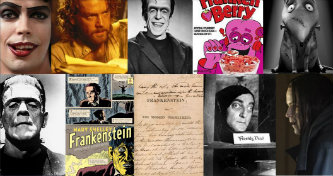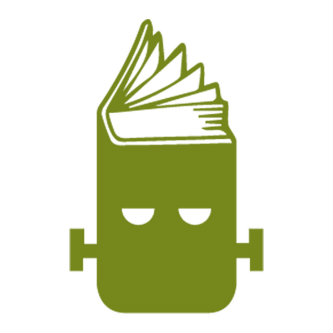Frankenreads Breathes New Life into "Frankenstein" this Halloween
Lehigh will facilitate several events for Frankenreads, a celebration of the 200th birthday of Mary Shelley's masterpiece.
Genetically-modified foods have been dubbed “Frankenfoods.” The cronut, a cross between a croissant and a doughnut, birthed the term “Frankenpastry.” When Hurricane Sandy combined with another storm system, the resulting super storm was christened a “Frankenstorm.”
These “Frankenwords” illustrate just how enduring—and integrated into popular culture—Mary Shelley’s novel Frankenstein is.
This Halloween, institutions around the world will mark the 200th birthday of Shelley’s masterpiece with events and public readings of the full text of the novel. More than 550 participants in 46 countries from Brazil to Bhutan to Bethlehem, Pennsylvania—including universities, public libraries, schools, and museums— will host events celebrating the novel, especially by conducting public read-a-thons of the entire novel on Halloween Day 2018 and during Frankenweek: Oct. 24-31, 2018. The central Frankenreads event is a live public reading of Frankenstein in Washington D.C. on Wednesday, Oct. 31, 2018, on the steps of the Library of Congress.
Frankenreads, a project of the Keats-Shelley Association of America (K-SAA) supported by a Chairman’s grant from the National Endowment for the Humanities, is the brainchild of Elizabeth A. Dolan, associate professor of English at Lehigh.
Dolan first came up with the idea of doing a Bloomsday-like event to celebrate the bicentennial of Shelley’s book while a K-SAA board member. Bloomsday is an international event that celebrates Irish novelist James Joyce’s book Ulysses. Every year on June 16, the day the action of the novel takes place, scholars and enthusiasts all around the world stage public readings of the full text of the novel. The idea is to celebrate the 200th anniversary of Romanticism, of which Shelley’s novel is emblematic.
“‘This is our moment,’ I thought,” says Dolan. “It won’t come around for another one hundred years!”
Lehigh University and the Bethlehem Area Public Library (BAPL) will co-host numerous public events, including a live reading of the full text of Shelley’s Frankenstein from 10 a.m. to 7 p.m. on Halloween (Oct. 31) at the BAPL. The event, co-hosted by Lehigh’s English Department, is free and open to the public. Costumes are welcome. The Lehigh University Humanities Center will also partner with BAPL to host a Frankenstein reading group during the month of October, which is also free and open to the public.
Lehigh’s Health, Medicine and Society Program and ArtsQuest co-sponsored a screening of the 1931 “Frankenstein” film, directed by James Whale and starring Boris Karloff, at SteelStacks Banko Alehouse Cinema on Wednesday, Oct. 17 at 7:30 p.m. On Friday, Oct. 26 at 7 p.m., Lehigh’s Center for Community Engagement co-hosted an on-campus screening of the 1974 comedy by Mel Brooks, “Young Frankenstein,” at Sinclair Auditorium. Lehigh’s Department of English co-sponsored a screening of “Mary Shelley’s Frankenstein,” directed by Kenneth Branagh, at BAPL’s main branch on Oct. 27 at 1 p.m. All screenings are free and open to the public.
Published in 1818 and often cited as the first science fiction novel, Frankenstein, or The Modern Prometheus was written by Shelley when she was 19 years old and published when she was just 20. The story was famously conceived while Shelley was a guest at Lord Byron’s summer rental home near Geneva, along with her husband, the poet Percy Shelley.
According to Dolan, that summer was particularly cold and dark due to climate abnormalities driven by a rare volcanic eruption in what is now Indonesia. This circumstance kept the vacationers indoors, during which time the host, Lord Byron, challenged each of his guests to write a ghost story. The story of Dr. Victor Frankenstein, a scientist grieving the loss of his mother who gives life to non-living matter in the form of “the creature,” is what Shelley created in response.
In an interview on the K-SAA website, the President of the K-SAA Board, Neil Fraistat, says he was so taken by Dolan’s suggestion to create a global celebration of Frankenstein because of the sheer amount of interest in the novel worldwide.
“In the United States, it is one of the most read novels in both high school and college curricula and remains a cultural touchstone because of its rich cinematic history,” says Fraistat. “I have always thought of Frankenstein as a crucial means of communicating Romanticism to the world, which is a key mission of the Keats-Shelley Association of America.”
What is it about the novel that allows it to endure?
“Something about it invites people to change it, to update as a reflection of current anxieties,” says Dolan. “There is a repeated cultural focus on the monster—though the story is about Victor and his irresponsibility, the lack of care for his creation. The focus on the creature mirrors anxieties about our own power and our wrestling with such thoughts as: ‘Maybe I shouldn’t have made it’ and ‘What if it gets out of control?’”
This semester Dolan is teaching an English graduate seminar focused on themes related to Shelley’s Frankenstein, the texts that lead up to it and its impact on popular culture. Dolan is also teaching an undergraduate course cross-listed in English and Health, Medicine and Society called “The Afterlives of Frankenstein: Bioethics, History of Science, and Literature,” which explores issues related to bioethics and the history of science and medicine.
“The time during which Shelley was writing was an era of major breakthroughs that really changed science and medicine—such as discovering oxygen’s role in respiration,” says Dolan. “It was also the height of the medical interest in detailed anatomy and dissection in Britain.”
Dolan notes that aspects of the novel can take on new resonance depending what is going on in society at the time. For example, in 1999 she was teaching Frankenstein during the time period following the murder perpetrated by two troubled students of 12 students and one teacher at Columbine High School in Colorado.
“It brought to the fore such questions as ‘What is the responsibility of the people around Victor’s monster?” says Dolan. “The monster is kind-hearted but he gets rejected time and time again. What are the downstream effects of the violent events he experiences? Victor doesn’t take responsibility.”
Another example: the current global refugee crisis is reflected in the monster’s search for home.
“What resonates for me is that the creature has no home, is wandering,” says Dolan. “He wants to go to South America, wants Victor to make a female companion to go with him. When Victor refuses, the two men chase each other around the Arctic with murderous intentions.”
At this point in the novel, according to Dolan, the creature can be seen as a kind of refugee which prompts the question: “Where is the home for ‘the other’?”
In the novel, the story of Frankenstein is first told to a seafarer who comes across Victor, the creature’s creator, while Victor is chasing the monster around the world. Victor tells the seafarer his side of the story. Later, when the creature appears, the creature tells his own side of the story to Victor.
“The novel explores ‘narrative ethics,’” says Dolan, “which is the idea that for every story there are multiple voices and multiple points of view.”
Posted on:






